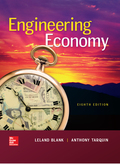
Calculate the incremental benefit–cost ratio of the mutual alternative.
Explanation of Solution
Model DA: Cost (C) is $200,000,000. The annual maintenance cost (AM1) is $360,000 in the first year, and it (AMI) increases by $10,000 per year. In year (n1) 25, the remodeling expenditure (RE) is $4,800,000.
Model CS: Cost (C) is $50,000,000. The annual maintenance cost (AM1) is $175,000 in the first year, and it (AMI) increases by $8,000 per year. The re-painting cost (RP) is $100,000 per 10 year except in year 50.
The time period (n) is 50 years. Revenue (RD1) from the alternate DA is $10,900,000 greater than the alternate CS, and it (RDI) increases by $200,000 per year till the year (n2) 15. Thereafter, revenue (RD15) is $13,700,000 per year, and the time period (n3) is 10, (n4) is 20, (n5) is 30, and (n6) is 40. The salvage value is $5 million for both the projects. The interest rate (i) is 8%.
Since both the projects have the same salvage value, it is ignored in the calculation of benefit–cost ratio. The present worth of cost for alternate DA (PWDA) can be calculated as follows:
The present worth of the alternate is $206,500,868.56.
The present worth of cost for alternate CS (PWCS) can be calculated as follows:
The present worth of the alternate is $53,260,192.47.
The present worth of the incremental benefit (PWB) between alternates DA and CS can be calculated as follows:
The present worth of the incremental benefit is $153,209,100.17.
The incremental benefit–cost ratio (BC) between the initial alternate do nothing and the new alternate 1 can be calculated as follows:
The incremental benefit–cost ratio is 1. Since the incremental benefit cost ratio is equal to 1, select the new alternate DA and eliminate the alternate CS.
Want to see more full solutions like this?
Chapter 9 Solutions
Engineering Economy

 Principles of Economics (12th Edition)EconomicsISBN:9780134078779Author:Karl E. Case, Ray C. Fair, Sharon E. OsterPublisher:PEARSON
Principles of Economics (12th Edition)EconomicsISBN:9780134078779Author:Karl E. Case, Ray C. Fair, Sharon E. OsterPublisher:PEARSON Engineering Economy (17th Edition)EconomicsISBN:9780134870069Author:William G. Sullivan, Elin M. Wicks, C. Patrick KoellingPublisher:PEARSON
Engineering Economy (17th Edition)EconomicsISBN:9780134870069Author:William G. Sullivan, Elin M. Wicks, C. Patrick KoellingPublisher:PEARSON Principles of Economics (MindTap Course List)EconomicsISBN:9781305585126Author:N. Gregory MankiwPublisher:Cengage Learning
Principles of Economics (MindTap Course List)EconomicsISBN:9781305585126Author:N. Gregory MankiwPublisher:Cengage Learning Managerial Economics: A Problem Solving ApproachEconomicsISBN:9781337106665Author:Luke M. Froeb, Brian T. McCann, Michael R. Ward, Mike ShorPublisher:Cengage Learning
Managerial Economics: A Problem Solving ApproachEconomicsISBN:9781337106665Author:Luke M. Froeb, Brian T. McCann, Michael R. Ward, Mike ShorPublisher:Cengage Learning Managerial Economics & Business Strategy (Mcgraw-...EconomicsISBN:9781259290619Author:Michael Baye, Jeff PrincePublisher:McGraw-Hill Education
Managerial Economics & Business Strategy (Mcgraw-...EconomicsISBN:9781259290619Author:Michael Baye, Jeff PrincePublisher:McGraw-Hill Education





